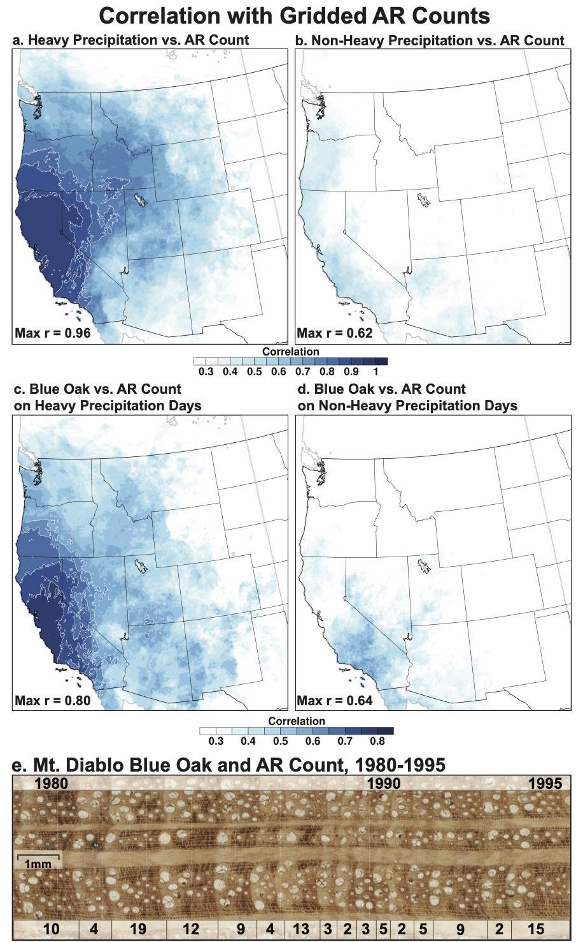CW3E Publication Notice
A 440-Year Blue-Oak Reconstruction of Heavy Precipitation in California
February 2, 2023
Ian Howard, a post-doc from the University of Arkansas and CW3E collaborator, alongside co-authors David W. Stahle (University of Arkansas), Michael D. Dettinger (CW3E), Cody Poulsen (CW3E), F. Martin Ralph (CW3E), Max C.A. Torbenson (Johannes Gutenberg University), and Alexander Gershunov (CW3E), have published a paper titled “A 440-Year Reconstruction of Heavy Precipitation in California From Blue Oak Tree Rings” in the American Meteorological Society’s Journal of Hydrometeorology. This research advances the goals of CW3E’s 2019-20024 Strategic Plan by its contribution to Atmospheric Rivers Research and Applications, quantifying longer-than-instrument-period variations of extreme precipitation in Northern California through a novel analysis of blue-oak ring-width chronologies. The strong relationship between certain blue oak chronologies and total water year precipitation (correlation, r ≥ 0.90) has been known for years (Stahle et al. 2013). However, this study (Howard et al. 2023) advances our understanding of this relationship by discovering that some blue oak chronologies are equally well correlated (r = 0.82) with annual totals of just the heavy-precipitation fraction of precipitation (daily totals ≥ 1 in, ≈95th percentile of historical daily totals). In contrast, the correlation with non-heavy precipitation totals using the same chronologies is much weaker (daily totals < 1 inch; r = 0.55). On average, heavy precipitation accounts for only 39% of water year totals in the study region but largely determines year-to-year precipitation variations. Thus, as noted in previous studies of California heavy-precipitation variability (e.g., Dettinger and Cayan 2014), these days of heavy precipitation dictate most of the occurrence of our droughts and flood years.
The study developed a reconstruction of heavy-precipitation totals in northern California from 1582-2021 (Fig. 1), 440 years in all. The reconstruction identifies decadal to multi-decadal surges in extreme precipitation totals and volatility. Return-period estimates based on the 440-year heavy-precipitation reconstruction are quite close to recurrence estimates based on just the instrumental record. This suggests that the 73 yearlong instrumental record over the study area provides a good representative of the variance in heavy precipitation during the last 440 years (Fig. 2). Finally, a comparison of annual landfalling atmospheric river counts to the reconstructed and instrumental heavy precipitation records shows large contributions of atmospheric rivers to the variations of heavy precipitation and blue oak growth (Fig. 3).
Figure 1: (a) The tree-ring reconstruction of heavy precipitation totals in the northern California study area are plotted (gray) along with the sub-decadal smooth values (black) and the heavy instrumental totals (red). The reconstruction extends from 1582-2004 and the CPC instrumental observations are appended from 2005-2021. The mean and upper and lower 20th percentiles computed for the full period 1582-2021 are also plotted. The reconstruction and instrumental values are correlated from 1949-2004 at r = 0.82.
Figure 2: Return periods and probabilities are plotted for the instrumental and reconstruction heavy precipitation totals (daily amounts ≥25.4mm). The black line connects the discrete return periods computed for the full 440-year reconstruction (1582-2021) and the blue dots are return periods for non-overlapping 50-year intervals in the reconstruction. Instrumental return periods are plotted for 1949-1998 (orange circles) and 1949-2021 (squares). Reconstructed return periods restricted to 1949-1998 are also plotted for comparison (red circles).
Figure 3: (a) Instrumental heavy precipitation (a) was correlated with gridded AR counts (Gershunov et al. 2017) on the specific days each year when heavy precipitation (≥25.4mm) was measured for the study area in northern California. These days of heavy precipitation vary from 2 to 28 days (1949 and 2017, respectively). (b) Non-heavy precipitation was also correlated with gridded AR counts on the corresponding non-heavy days also defined for northern California. The regional blue oak chronology was correlated with gridded AR count on the days with (c) heavy and (d) non-heavy precipitation in the study area [p <0.05 for all correlations mapped, 1949-2004, contour intervals plotted above 0.80 in (a), above 0.60 in (c)]. Note the area of highest correlations (>0.95) near Monterey Bay in (a). (e) A photomicrograph of ring porous annual rings in blue oak from Mt. Diablo is reproduced for 1980-1995, along with the count of landfalling ARs near the Golden Gate to illustrate the proportionality between oak growth and AR-delivered heavy precipitation. The annual rings are oriented vertically, and two medullary rays run horizontally through the ring sequence.
Dettinger, M., & Cayan, D. R. (2014). Drought and the California delta – A matter of extremes. San Francisco Estuary and Watershed Science, 12,, 1-6. https://doi.org/10.15447/sfews.2014v12iss2art4
Howard, I. M., Stahle, D. W., Dettinger, M. D., Poulsen, C., Ralph, F. M., Torbenson, M. C. A., & Gershunov, A. (2023). A 440-Year Reconstruction of Heavy Precipitation in California from Blue Oak Tree Rings*. Journal of Hydrometeorology (published online ahead of print). https://doi.org/10.1175/JHM-D-22-0062.1
Stahle, D. W., Griffin, R. D., Meko, D. M., Therrell, M. D., Edmondson, J. R., Cleaveland, M. K., Stahle, L. N., Burnette, D. J., Abatzoglou, J. T., Redmond, K. T., Dettinger, M. D., & Cayan, D. R. (2013). The Ancient Blue Oak Woodlands of California: Longevity and Hydroclimatic History. Earth Interactions, 17, 1-23. https://doi.org/10.1175/2013EI000518.1



